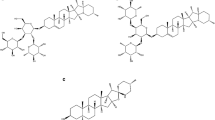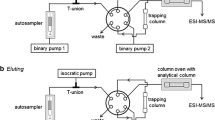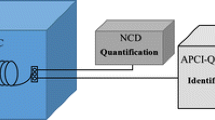Abstract
A method is described for liquid chromatography–mass spectrometry analysis of the cardio glycosides digoxin and digitoxin in biological samples. The method was optimized for use in the forensic field and, therefore, comprises the determination from whole blood and tissue samples. Sample cleanup by solid phase extraction (SPE) on a functionalized polymeric phase was sufficient to limit matrix suppression to <10% for all analytes. Chromatographic separation was achieved using an RP-8 column. Detection of the cardio glycosides was performed with electrospray ionization in the positive mode. The system was run in single ion monitoring mode, measuring the sodium adducts (M + Na)+ of the analyte and of the internal standard, respectively. The method was fully validated for the analysis of blood samples and was also successfully applied in forensic cases. The method was accurate and precise over a linear concentration range up to 50 ng/g blood. Lower limit of quantitation was 0.2 ng/g for digoxin and 2 ng/g for digitoxin, respectively. As deuterated analyte was used as internal standard, we also present a new microwave-enhanced method for the fast preparation of the labelled analyte within 20 min.



Similar content being viewed by others
References
Adamowicz P, Chudzikiewicz E, Kala M (2002) Digoxin in a forensic laboratory. Z Zag Nauk Sadow 49:114–127
Arnold W, Puschel K. (1979) Forensic aspects of digoxin-poisoning. J Leg Med 83:265–272
Valdes R, Jr., Jortani SA (2002) Unexpected suppression of immunoassay results by cross-reactivity: now a demonstrated cause for concern. Clin Chem 48:405–406
Steimer W, Muller C, Eber B, Emmanuilidis K (1999) Intoxication due to negative canrenone interference in digoxin drug monitoring. Lancet 354:1176–1177
Van Landeghem AA, De Letter EA, Lambert WE, Van Peteghem CH, Piette MHA (2007) Aconitine involvement in an unusual homicide case. Int J Legal Med 121:214–219. DOI 10.1007/s00414-006-0119-5
Pietsch J, Oertel R, Trautmann S, Schulz K, Kopp B, Dreßler J (2005) A non-fatal oleander poisoning. Int J Legal Med 119:236–240
Yao M, Zhang H, Chong S, Zhu M, Morrison RA (2003) A rapid and sensitive LC/MS/MS assay for quantitative determination of digoxin in rat plasma. J Pharm Biomed Anal 32:1189–1197
Lacassie E, Marquet P, Martin-Dupont S, Gaulier JM, Lachatre G (2000) A non-fatal case of intoxication with foxglove, documented by means of liquid chromatography–electrospray–mass spectrometry. J Forensic Sci 45:1154–1158
Tracqui A, Kintz P, Ludes B, Mangin P (1997) High-performance liquid chromatography–ionspray mass spectrometry for the specific determination of digoxin and some related cardiac glycosides in human plasma. J Chromatogr B Biomed Sci Appl 692:101–109
Guan F, Ishii A, Seno H, Watanabe-Suzuki K, Kumazawa T, Suzuki O (1999) Identification and quantification of cardiac glycosides in blood and urine samples by HPLC/MS/MS. Anal Chem 71:4034–4043
Plum J, Daldrup T (1986) Detection of digoxin, digitoxin, their cardioactive metabolites and derivatives by high-performance liquid chromatography and high-performance liquid chromatography-radioimmunoassay. J Chromatogr 377:221–231
Kaiser P, Akerboom T, Wood WG, Reinauer H (2006) A novel LC–IDMS/MS method for the determination of the cardiac glycosides digoxin and digitoxin using caesium adducts. Clin Lab 52:37–42
ICH (1995) Harmonised tripartite guideline Q2 (R1): validation of analytical procedures: text and methodology. Fed Regist 60:11260
Matuszewski BK, Constanzer ML, Chavez-Eng CM (2003) Strategies for the assessment of matrix effect in quantitative bioanalytical methods based on HPLC–MS/MS. Anal Chem 75:3019–3030
Hayes BL (2004) Recent advances in microwave-assisted synthesis. Aldrichimica Acta 37:66–77
Anto S, Getvoldsen GS, Harding JR, Jones JR, Lu S-Y, Russell JC (2000) Microwave-enhanced hydrogen isotope exchange studies of heterocyclic compounds. J Chem Soc Perkin Trans 2:2208–2211
Keßler A (2001) Massenspektrometrische Isotopenverdünnungsanalyse von Digoxin und Digitoxin in menschlichem Serum-Referenzmethoden in der Klinischen Chemie, Dissertation zur Erlangung des Doktorgrades, Rheinische Friedrich-Wilhelms-Universität Bonn
Aulabaugh AE, Crouch RC, Martin GE et al (1992) The conformational behavior of the cardiac glycoside digoxin as indicated by NMR spectroscopy and molecular dynamics calculations. Carbohydr Res 230:201–212
El Nemr A, Tsuchiya T (1998) A convenient method for deuteration at the alpha position of an oxo group in carbohydrates. Tetrahedron Lett 39:3543–3546
Pickup JF, McPherson K (1976) Theoretical considerations in stable isotope dilution mass spectrometry for organic analysis. Anal Chem 48:1885–1890
Kommission EU (2002) 2002/657/EC. Off J Eur Communities L Legis 221:8–36
U.S. Department of Health and Human Services FDA, Center for Drug Evaluation and Research, Center of Veterinary Medicine (2001) Guidance for industry: bioanalytical method validation. The United States Pharmacopeia Convention, Rockville, MD
Author information
Authors and Affiliations
Corresponding author
Rights and permissions
About this article
Cite this article
Frommherz, L., Köhler, H., Brinkmann, B. et al. LC–MS assay for quantitative determination of cardio glycoside in human blood samples. Int J Legal Med 122, 109–114 (2008). https://doi.org/10.1007/s00414-007-0175-5
Received:
Accepted:
Published:
Issue Date:
DOI: https://doi.org/10.1007/s00414-007-0175-5




